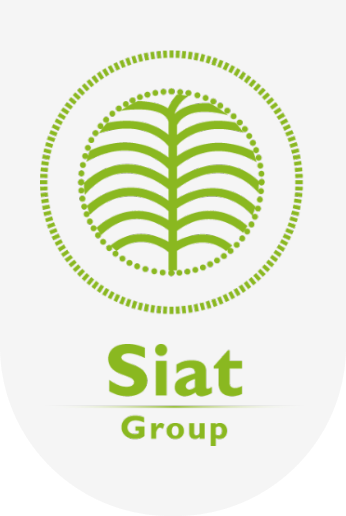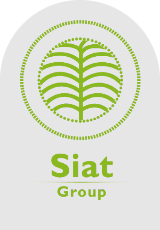Research & development
for agricultural optimization
Sustainable development in oil palm and hevea relies upon the understanding of underlying biological, human, and industrial processes, and the capacity to optimize production factors and their interactions.
Siat strongly supports this objective through continuous commitment to research and innovation that encompasses both agronomic R&D for yield intensification and process optimization as well as strategic long-term partnerships that keep us at the forefront of planting material development and agricultural digitalization.
These R&D efforts are built upon an enabling platform of collaborations with international research institutes, specialized input and service providers and universities in both Africa and Europe.
Agricultural R&D
& Information Management Systems
Agricultural productivity is determined by the interacting characteristics of genotype, environment, and management while optimalization is governed by the combined effects of yield determining, reducing, and limiting factors for intensification and efficiency assessments.


Optimizing Genotype-Environment-Management interactions within a sustainability framework is key to agricultural productivity and eco-efficiency
Yield gap analysis enables both land-use intensification and (economic) efficiency assessments

Our R&D department works closely with the plantation management for the implementation of research and support activities on agronomic practices, crop nutrition and soil fertility, mechanization and labour productivity, as well as phytosanitary monitoring and control. Further collaboration with ERP specialists for building and developing database systems ensures that all relevant data and information is captured in a correct and timely manner and linked to other business management modules. By integrating this Agricultural Information Management System into GIS and business intelligence platforms, it provides valuable tools and knowledge to support the decision-making process for plantation management.
A sound understanding of the physical environment and agro-ecological context across the extensive spatial and temporal scales of tree crop plantations is paramount for benchmarking the natural potential of the land. The use of elite planting material and best agricultural practices, adapted to site specifications through field experimentation, are essential management requirements to achieve the agronomic potential of the land. A cost-effective control of weeds, pests and diseases through integrated pest management reduces risks and ensures the productive potential in maintained throughout the lifecycles. Finally, a holistic field to factory integration connects the agricultural activities to the end products for greater quality assurances whilst also enabling economic evaluations and optimizations as well as resource recycling and circularities.
| Topics and Research Activities | Presco | SNL | GOPDC | CHC | |
| Fertilization and soil fertility | Ongoing | 6 | 2 | 2 | 2 |
| Completed | 4 | 2 | 7 | – | |
| Cumulative years | 71 | 14 | 65 | 10 | |
| Other Agronomy topics | Ongoing | 2 | – | – | 1 |
| Completed | – | – | – | 5 | |
| Cumulative years | 20 | – | – | 21 | |
| Planting Material Oil Palm | Ongoing | 27 | – | – | – |
| Completed | 4 | – | – | – | |
| Cumulative years | 261 | – | – | – | |
| Planting Material Hevea | Ongoing | 9 | – | 2 | 5 |
| Completed | – | – | – | – | |
| Cumulative years | 15 | – | 11 | 24 | |
Partnerships on oil palm
genetic improvement for Africa
Most trials aim to determine the breeding values of parents for a new generation of planting material. Other trials are part of larger international efforts to improve drought resistance and fertilizer use efficiency both critical for long term resilience in the lights of climate change and growing resource scarcity.
Moreover, the project further enables a diversification of disease resistant planting material as well as the introduction of additional traits of interest (improve quality, reduce processing losses, compact size to increase land productivity, etc.).
These efforts, by ensuring peperpetual progress in genetic potential and regional adaptation, not only provide the Siat group with guaranties regarding the quality of planting materials used but also safeguard the sustainable growth of the African oil palm industry in general, primarily by increasing yield and thus reducing the need for land conversion or deforestation.
Key partners

Tissue culture
for rubber material
Genotype – Environment – Management evaluation
By maintaining and strengthening long term collaborations with key actors in the private/public sectors and scientific world, we aim to contribute consistently and constructively to hevea planting material improvements with the aim to increase land and labour productivity and adapt natural rubber production to a changing world for the benefits of our plantations and the industry at large.
Natural rubber (NR) is a key component for the (electric) automotive and aviation industries and used in a broad range of industrial and consumable applications. The tropical tree Hevea brasiliensis is by far the greatest contributor to its production and the best option to sustainably meet the 50% increase in NR demand expected by 2050 with limited land area expansion.
NR is produced from latex obtained through non-destructive tapping (shaving with a sharp knife) of the bark once trees have sufficient girth (after a 5-8 year growing phase). Production can be sustained for over 2 decades resulting in long lifecycles that necessitate planting material with the best yield potential for the given environment. The breeding process this requires is long (20-30 years per generation) and a combination of factors (flowering patterns, fertility, fruit set and lack of seed dormancy) also make selection and propagation based on seeds alone unpractical. As a result, vegetative propagation through bud grafting has been used for over 100 years in commercial plantations and breeding programs with a tendency to focus on the scion (budwood clone) and less on the rootstock.
Tissue culture provides an alternative to vegetative propagation by bud-grafting through somatic embryogenesis and micropropagation with various prospects for improving agronomic potential and breeding progress through (i) production of clonal plants, grown on their own root systems, resulting in faster development and higher yield (at least for some clones) and providing complementary to breeding programs, (ii) production of clonal rootstock, enabling further selection on the rootstock and the rootstock-scion combinations
In 2013, Siat group, in close collaboration with Deroose Plants, initiated audacious efforts to scale up and optimize the production and acclimatization process of hevea micro-propagation. This is complemented by a partnership with CIRAD to scientifically evaluate the performance and potential of hevea planting material derived from tissue culture leading to the set-up of a large Genotype x Environment x Management experimental network with over 500 hectares of field plantings. This including 16 comparison trials and 9 clones, evaluated under contrasting environments in 3 West-African countries. Production started on the first trials planted in 2015 with promising results and field research is ongoing to deepen understanding of the biological, physiological, and agronomic characteristics of tissue cultured Hevea trees.
Key partners

Innovate & Support

Partnerships for Innovation & Optimization


